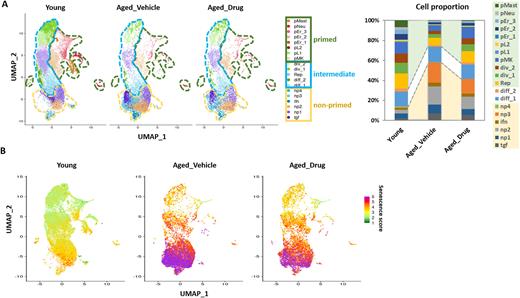Abstract
During aging, the heterogeneity and function of hematopoietic stem cells (HSCs) decline dramatically, contributing to a wide array of age-associated deficiencies and diseases such as anemia, leukemia, and immune system deterioration. Using a genetically engineered mouse model that enables inducible elimination of senescent cells, we have previously demonstrated that their clearance restored the repopulation capacity of aged HSCs. In this study, we use a new generation senolytic drug, 753b, to target senescent cells in old (100 weeks) mice to further dissect the link between senescence and HSCs aging. A short-term treatment (8 doses) achieved efficient depletion of senescent cells as seen by decreased expression of p16Cdkn2a in the liver tissue from 753b-treated group compared to vehicle control. To gain a high-resolution insight into the molecular physiology of young and aged HSCs before and after senolytic treatment, we analyzed 34,000 single-cell HSC transcriptomes using 10X Genomics Chromium platform. Unsupervised clustering analysis using Seurat algorithm on sorted Lin-Sca1+cKit+ (LSK) CD150+ cells from young, aged-vehicle, and aged-drug groups identified 19 distinct clusters. We further grouped these clusters into lineage non-primed (6 clusters), intermediate (5 clusters), and lineage-primed (8 clusters) subgroups (Fig. 1A) using a pipeline developed by Hérault et al. (BMC Biology, 2021). Consistent with previous observations, aged HSCs were characterized by a significant expansion of non-primed cell subpopulations and a reduction of primed cells. Remarkably, a short 8-dose course of 753b senolytic drug treatment largely reversed aging-related changes in HSCs distribution-proportion of non-primed HSCs decreased, while dividing cells in intermediate HSC clusters increased along with slight elevation within primed HSCs (Fig. 1A). Interestingly, cell cycle analysis showed cells within intermediate and primed stages present in a similar cycling pattern across young, aged, and drug treated groups. Yet, among aged HSCs more cells were locked in a less proliferative early non-primed state, with fewer cells transitioning into lineage-primed state. Excitingly, short term 753b treatment partially restored cell cycling in non-primed clusters in aged mice, suggesting possible rejuvenation of HSCs. We further compared differentially expressed genes between young and aged groups in non-primed clusters and found enrichment of pathways related to programmed cell death and cell differentiation. Senescence score generated based on this gene list by Seurat algorithm showed normalization of the aging-related gene signature upon 753b treatment, especially in non-primed HSCs (Fig. 1B).
Our study explores the transcriptomic heterogeneity and dynamics of HSCs during aging and after senolytic drug treatment at a single cell level and highlights potential mechanisms of senolytic drug-mediated hematologic recovery. The senescence score we generated can be further evaluated as a biomarker of aging of HSCs.
Figure 1. (A) UMAP showing the distribution of HSC cells among 19 clusters. Clusters were sub grouped into non-primed, intermediate, and primed groups. Cell proportions in each cluster were shown in bar graph from the indicated groups. (B) Senescence scores were calculated based on gene expression of top elevated genes.
Disclosures
No relevant conflicts of interest to declare.
Author notes
Asterisk with author names denotes non-ASH members.


This feature is available to Subscribers Only
Sign In or Create an Account Close Modal